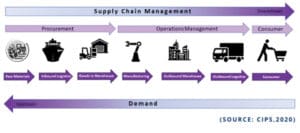The toughest decision I have to make as a writer is deciding on a relevant topic and writing the first paragraph. For this month’s article, which will be presented in two parts, the topic was chosen for me not by our faithful editors but, rather, by several of our readers and some close colleagues of mine. Please permit me to explain.
I have been having several ongoing conversations on the topic of the supply chain and its effect on our industry. One was with a VP of one of the largest integrators in the country. He was lamenting the issues he was having in supply shortages, noting that he had never seen them before.
The next conversations were with some of the largest distributors in the world, who were—you guessed it—lamenting supply and delivery issues. Last but not least, I heard from several large manufacturers about supply issues. If you think this was only the big integrators, distributors and manufacturers, you would be wrong. This issue affects the large, the medium and the small, not to mention end users. Hence, the impetus for the topic since it obviously impacts us all.
Related: Three Keys to Dealing with AV Supply Chain Issues
A fellow writer asked me what effect I thought the supply chain “logjams” would have on the market. Did I expect economic momentum to outweigh those issues? Good questions! For those wanting the Cliff’s Notes version, here is my response to him: “The ‘logjams’ you mention are already having a negative effect on the market. The big distributors and several of the large integrators around the country are having to ‘adjust’ their businesses to the flow of goods coming and the availability.
In some cases, those adjustments mean considering alternative products or brands because of availability; in others, they mean changing a design. In others, they mean postponing until the ‘logjams’ become less onerous. The economic momentum (aka demand) is there and growing, but the supply will take some time to catch up.” For those whose interest I have piqued and who want a deeper dive, stay tuned!
Nick Vyas, executive director of the Kendrick Global Supply Chain Institute at the University of Southern California, sets it up for us to understand the scale and scope of the problem. He says that, today, manufacturers and their customers face a “perfect storm” of supply-chain issues. Nicole DeHoratius, a professor at the University of Chicago’s Booth School of Business, opines, “We might be able to buffer against one type of risk or two types of risk, but it’s the fact that all these challenges are happening at the same time.”
Let’s take this beyond a sound bite and provide a cursory understanding of the supply chain, its complexities and where we are today as an industry.
What is the Supply Chain?
There are numerous definitions, but I found one from the Chartered Institute of Procurement and Supply (CIPS) that explains it succinctly. In its simplest form, a supply chain includes all the activities required by an organization to deliver goods or services to the consumer.
In a more granular sense, a supply chain focuses on the core activities within an organization required to convert raw materials or component parts through to finished products or services. Figure 1 depicts the process from procurement of raw materials or components to the warehouse; then, it goes to manufacturing, after which it goes to the outbound warehouse, then, via logistics, it goes to the consumer.
Now, you have a 30,000-foot view of the supply chain. However, the issues surrounding it cannot be condensed into a simple graphic. The seriousness cannot be overstated because this affects everyone, everywhere. Let’s begin whence it came.
In the Beginning…
The origins of what is known as supply chain management (SCM) can be traced back to the 1980s, when corporations sought to lower production costs by outsourcing and offshoring manufacturing and R&D activities to low-cost countries in Asia. As one SCM researcher notes, “Over time, practices that called for continuous flow processing with low inventory levels, just-in-time (JIT) production and accurate scheduling of transport became common.” This originated on the cusp of the burgeoning global economy.
It has been the norm for decades for manufacturers in the U.S. and the rest of the industrialized world to outsource the production of common and low-cost products to China and other low-wage countries. However, starting in the early 1980s, companies increasingly outsourced the production of more sophisticated products, often using multiple contractors to produce and then assemble the components.
Here’s how it typically works: A company based in the U.S. will design and perhaps put the finishing touches on a product, but that company will turn to one or more foreign manufacturers for raw materials and components if doing so will significantly cut the cost to build and deliver that product. A prime example is in the auto industry, where roughly half of one manufacturer’s most popular trucks rolled out of a U.S. auto plant last year with parts and components that came from outside the U.S. and Canada. Pick almost any industry and this applies.
The Problems Today
Looking back, we can see that, during the early 2000s, corporations encountered supply problems and researchers began to write books about how to deal with disruptions. In 2019—thus, before the pandemic—the Business Continuity Institute (BCI) estimated that 56% of companies surveyed suffered some variation of one or more supply disruptions annually. The BCI further informs us that, back in the day, issues were mainly due to IT and telecommunications outages or natural disasters. Human and political factors also played a role in the latter part of the decade, however.
Read: Integrators: Beware More Supply Chain Cyber Attacks
Gooten, a U.S.-based supply-chain company, provides us with more insights that illustrate one of the reasons for the issues we’re having today. Companies that utilize on-demand production begin producing products only once a customer has purchased them, rather than the company forecasting what the demand for a product might be and producing a set number of those products.
The same JIT manufacturing and inventory model has permeated everything we produce. According to Mark Kapczynski, chief marketing officer at Gooten, “We have to change our paradigms in light of what we are now experiencing.” Think about it.
Inherent in JIT and on-demand production is the risk presented by any one of the elements of the supply chain. Each risk, if encountered, can have a domino effect upstream and downstream.
One great example in the AV industry—consumer and commercial alike—is that a missing chip can halt production of electronic devices. The good news is that corporations are already shifting from reactive tactics to mitigate the cost of disruptions to more proactive strategies to improve supply-chain resilience.
Gina Raimondo, the U.S. Secretary of Commerce, recently hosted an industry summit focused on the chip shortage. It included executives from companies like Ford and General Motors, as well as Apple and Samsung.
Afterward, her office said that one of its goals is to build supply-chain trust. (Another goal is to explore how the U.S. can become less dependent on overseas suppliers.)
A Bloomberg article reports, “Samsung Electronics Co. has decided to build an advanced U.S. chip plant in Texas…as it prioritizes supply chain security and greater semiconductor capacity on American soil.” My crystal ball tells me to look for other companies to follow suit ASAP in their response to the supply-chain issues.
All else aside, it is in their best interest, and they have no other viable choices. The status quo is not sustainable.
Editor’s Note: Part 2 of this column will published next month online and in our February 2022 print edition.











